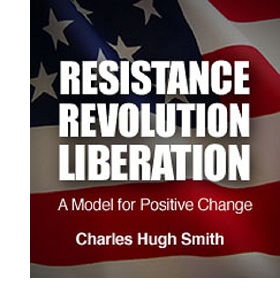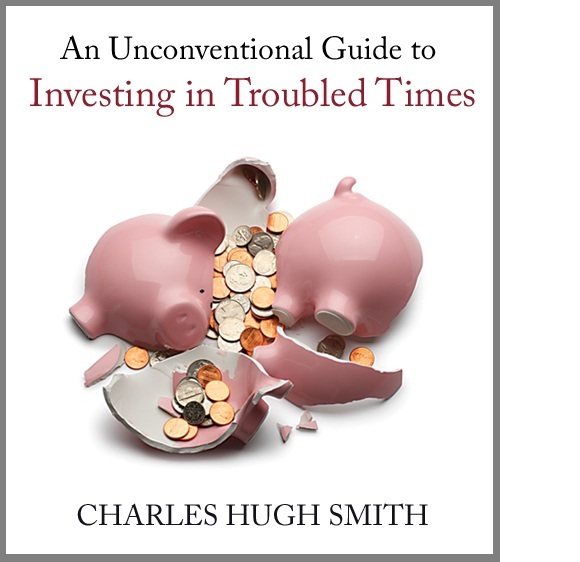

|

|
|||||||||||||
|
Why the Job Market Will Continue Shrinking (May 8, 2012) The paradox of an advanced post-industrial economy is that the number of jobs needed declines even as the cost of living rises. The fundamental dynamic of America's job market is simple: we need relatively few workers to provide the absolute essentials of life even as the cost-basis of the economy inexorably rises. In other words, there are fewer jobs even as the costs of maintaining a "middle class" life rise. Let's start by observing how all the financial data in the world does not necessarily describe the primary dynamics of an economy. There are a number of factors that cause this disconnect between the primary forces at work beneath the surface and the data. One is that economists tend to focus on situations with abundant, easy-to-interpret data. If you're only looking for roses, then you ignore everything that isn't a rose. So economists seek dynamics that can be easily explained by available data, and financial factors that they are paid to examine. Everything else is ignored, especially if the act of examining it casts a skeptical light on a self-serving Status Quo. One key reality that is rarely if ever discussed is that the number of workers needed to provide the bare essentials of life to the 313 million residents of America is modest. Let's stipulate that bare essentials include food, heat in winter, clean water, sewage and waste disposal, public health (innoculations against pandemics, etc.), public safety and enough energy to fuel these essentials. If life were suddenly reduced to these basics, and no energy were available for anything but these essentials, then how many full-time workers would be needed? Roughly 1% of the workforce raises the vast majority of our food, and a modest number of workers maintain the water and sewage systems, natural gas pipelines, furnaces, etc., A similarly modest number of workers maintain public health and safety and provide transport of essentials. Of the official workforce of 154 million, how many fall into this "absolute essentials of life" category? Perhaps 10% or 15 million people? Even if we double that to include all sorts of non-essential but "critical" goods and services, then that's perhaps 30 million workers, roughly 10% of the population and about 12.5% of the real workforce of 240 million (the Federal government has relegated roughly 88 million working-age people to the zombie-status of "not in labor force" to keep the official unemployment rate low). We all know the dynamic behind this dramatic reduction in the number of people needed to provide the essentials of life: enormous increases in productivity based on abundant fossil fuels and advanced technology. Even well-made infrastructure requires maintenance, but this process of replacing aging transmission lines, water mains, highways, refineries, etc. requires a relatively modest number of workers because machines do much of the work. If you doubt this, stop and count the workers on a major repaving project or the construction of a highrise building. A very large multi-story building is generally assembled by about 100-150 workers, more during certain stages and less during others. Most of the components are fabricated in factories where machines do most of the work. Ask how many frontline police officers are on your local force. Cities of a few hundred thousand might have 200-300 officers, larger cities might have 800-1,000. It's not a large number. On a macro-scale, the challenge in advanced economies is creating "make-work" for 80% of the working age population. This is not an issue in developing economies, as most of the workforce is non-market and does not participate much in the cash economy. For example, only 7% of India's vast workforce of hundreds of millions of people gets a paycheck. The other 93% survive via barter, raising their own food, a bit of trade or occasional labor for cash, etc. Before industrialization, roughly 50% of the U.S. population and workforce lived and worked on farms. The surplus of their labor fed the other 50% who lived in urban areas, and that cash supplied the few essentials the rural dwellers needed. The paradox of post-industrial economies is that the cost of living rises even as the efficiencies of providing essentials reduces the number of essential jobs. Some of this may be due to Baumol's Disease, a topic I have covered before (Productivity, Baumol's Disease and the Cliff Just Ahead, December 8, 2010). Baumol's cost disease is named after economist William J. Baumol, who with William G. Bowen described a critical difference between goods-producing and labor-intensive work. Baumol and Bowen noted that if productivity/wages rose by 2.2% a year and costs rose by 2%, then over time workers could buy more of everything--goods, services and government services paid for with taxes. They also observed a critical, long-term difference between the rates of productivity growth in goods-producing industries and labor-intensive industries such as nursing and teaching. (I would also include the Armed Forces as an example.) Goods-producing industries could achieve very high productivity growth as labor-saving automation and supply-chain efficiencies scaled up, while nursing and teaching required the same number of hours with patients or students as in years past. In other words, productivity in labor-intensive services has intrinsically lower rates of productivity increases than goods-producing industries. Baumol and Bowen then described the peculiar result of this: as GDP increased due to goods-producing improvements in productivity, the relative share of low-growth-productivity services would rise. Thus machine-produced TV sets and computers fall in price while labor-intensive healthcare costs rise. While this is undoubtedly one causal factor, it is not the only causal factor. I think there is an implicit assumption being made on both a policy and cultural level that higher costs are acceptable because it "means more people are being put to work." So when the cost per military fighter aircraft leaps from $56 million each (the F-18) to $200 million and $300 million (the F-22 and F-35), then we accept this as OK because we assume more jobs will be created as costs rise. Gross waste and inefficiency is thus accepted as the "cost" of creating more jobs. The problem with this implicit pact is that a rising percentage of these jobs are friction: they do not increase productivity or wealth, they merely consume wealth. In the case of fighter aircraft, the cost has leaped so dramatically that it is now apparent the nation cannot afford a fleet of these hyper-costly (and apparently troubled) aircraft. Will 100 of these aircraft prevail over 1,000 dirt-cheap drones? How about 10,000 drones? If the future of warfare is increasingly powerful unmanned networked drones (and it clearly is), why are we spending $1 trillion+ on hyper-costly aircraft that are essentially designed for a previous era? We're not building miltary dominance with these programs, we're sinking money down ratholes, just as we're not "buying" more health with our 17% of GDP spent on sickcare, we're simply managing more chronic diseases. In the case of healthcare, patients being issued $1,000 a month in medications are not necessarily "getting better," rather many thousands are dying of accidental overdoses. Though the U.S. spends twice as much as other advanced democracies as a percentage of GDP on healthcare, Americans are arguably less healthy in aggregate than the citizens of Japan and Australia, nations that spend about 8% of GDP on healthcare while the U.S. spends 17% of GDP. These are but two examples of trillion-dollar friction that is sapping the nation's wealth and vitality. Since the nation cannot actually afford to spend $1 trillion on the F-35 program or $2.5 trillion every year on a healthcare system of which at least 40% is fraud or paper-pushing, then we have been borrowing $1.5 trillion every year to maintain the illusion that these trillion-dollar sinkholes are sustainable. The solution to the post-industrial decline of labor is not unproductive "make-work" jobs and borrowing trillions of dollars until the system implodes, it's lowering the cost basis of the entire economy and culture. The central paradox of an advanced post-industrial economy is that the number of jobs needed declines even as the cost of living rises. The only way out of that paradox is to radically reduce the cost-basis of the entire economy, which means eliminating all the systemic sources of unproductive friction.
I will discuss this further in the days ahead.
For small gardens:
The Simple Garden - Special price: $29.95 + $8.00 shipping
 Resistance, Revolution, Liberation: A Model for Positive Change
(print $25)
Resistance, Revolution, Liberation: A Model for Positive Change
(print $25)
(Kindle eBook $9.95) Read the Introduction (2,600 words) and Chapter One (7,600 words) for free.
We are like passengers on the Titanic ten minutes after its fatal encounter with the iceberg: though our financial system seems unsinkable, its reliance on debt and financialization has already doomed it.

If this recession strikes you as different from previous downturns, you might
be interested in my book
An Unconventional Guide to Investing in Troubled Times (print edition)
or
Kindle ebook format. You can read the ebook on any
computer, smart phone, iPad, etc. Click here for links to Kindle apps and Chapter One.
The solution in one word: Localism.
Of Two Minds Kindle edition: Of Two Minds blog-Kindle

"This guy is THE leading visionary on reality.
He routinely discusses things which no one else has talked about, yet,
turn out to be quite relevant months later."
NOTE: gifts/contributions are acknowledged in the order received. Your name and email remain confidential and will not be given to any other individual, company or agency.
Or send him coins, stamps or quatloos via mail--please request P.O. Box address. Subscribers ($5/mo) and contributors of $50 or more this year will receive a weekly email of exclusive (though not necessarily coherent) musings and amusings. At readers' request, there is also a $10/month option. The "unsubscribe" link is for when you find the usual drivel here insufferable.
All content, HTML coding, format design, design elements and images copyright © 2012 Charles Hugh Smith, All rights reserved in all media, unless otherwise credited or noted. I would be honored if you linked this essay to your site, or printed a copy for your own use.
Terms of Service:
|
Add oftwominds.com to your reader:
My Big Island Girl
Instrumentals by my friend
|
| Survival+ | blog fiction/novels articles my hidden history books/films what's for dinner | home email me | ||